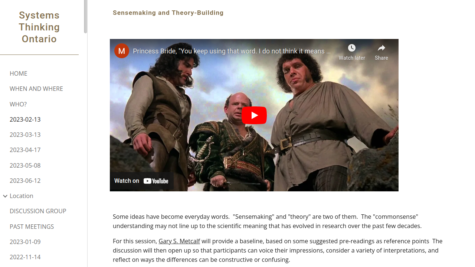The theme for the February online meeting of Systems Thinking Ontario was sparked from the discussion from the January session on Root Metaphor and World Hypotheses. What does it mean to have a theory? How does sensemaking contribute to this?
Gary Metcalf volunteered to guide a conversation on these topics. Two prereadings were to serve as an orientation for the diligent:
- Chun Wei Choo, “The Management of Ambiguity: Organizations as Sensemaking Communities”, The Knowing Organization, https://doi.org/10.1093/acprof:oso/9780195176780.003.0003 , available at http://choo.fis.utoronto.ca/FIS/Courses/LIS2102/SM.chap3.html .
- Eisenhardt, K. M. & Graebner, M. E. (2010). Theory building from cases: opportunities and challenges. Paper presented at PMI® Research Conference: Defining the Future of Project Management, Washington, DC. Newtown Square, PA: Project Management Institute. at https://www.pmi.org/learning/library/theory-building-case-studies-opportunities-6440
A smaller group convened for this discussion, enabling full participation by each and every attendee. After a quick round of introductions , the conversation started around 4m20s in.
This recording of the session is available on Youtube, as well as on the Internet Archive .
| Video | H.264 MP4 |
| February 13 (1h42m) |
[20230213_ST-ON_Metcalf SensemakingTheoryBuilding.m4v] (QHD 2560×1440 265kbps 289MB) [on the Internet Archive] |
A standalone audio was also created during the meeting.
| Audio | |
| February 13 (1h42m) |
[20230213_ST-ON_Metcalf SensemakingTheoryBuilding.m4a] (94.2MB) |
The conversation flowed naturally. I commented that before Gary was a professor of organizational systems, he had a prior career in family therapy.
Here is the original abstract sent in advance.
Some ideas have become everyday words. “Sensemaking” and “theory” are two of them. The “commonsense” understanding may not line up to the scientific meaning that has evolved in research over the past few decades.
For this session, Gary S. Metcalf will provide a baseline, based on some suggested pre-readings as reference points The discussion will then open up so that participants can voice their impressions, consider a variety of interpretations, and reflect on ways the differences can be constructive or confusing.



